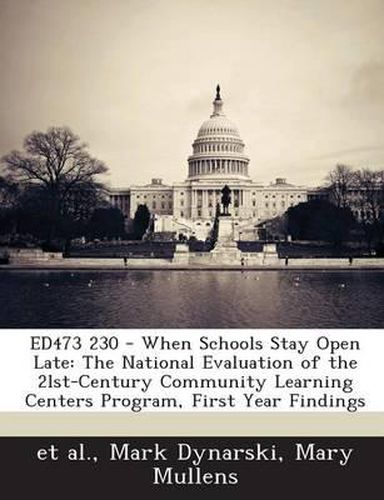Readings Newsletter
Become a Readings Member to make your shopping experience even easier.
Sign in or sign up for free!
You’re not far away from qualifying for FREE standard shipping within Australia
You’ve qualified for FREE standard shipping within Australia
The cart is loading…






First authorized in 1994, the 2lst-Century Community Learning Centers program supports after-school programs in approximately 7,500 rural and inner-city public schools . A distinguishing characteristic of 21st- Century programs is the inclusion of academic activities. This report presents the first-year findings from an evaluation of the program. Elementary school students were randomly assigned to treatment and control groups. The middle school sample was comprised of a nationally representative sampling of after-school programs and participants, and a matched comparison group. The first-year findings revealed that while 2lst-Century after-school centers changed where and with whom students spent some of their after-school time and increased parental involvement, they had limited influence on academic performance, no influence on feelings of safety or on the number of latchkey children, and negative influences on behavior. In the middle school centers, homework help sessions were typically organized with students in large groups proctored by teachers or other staff, and homework was not checked for quality or completeness. Middle school participants, averaging attendance of one day per week, were more likely than nonparticipants to report that they sold drugs, smoked marijuana, or had their personal property damaged. Elementary programs reduced the time students spent at home cared for by a parent or sibling but did not reduce self-care. Key implementation findings indicate that grantees had succeeded in implementing their planned programs and in gaining support from and creating working relationships with school principals and teachers. Most programs provided academic, enrichment, and recreation activities, but made limited efforts to plan for sustainability. The report’s two appendices contain information on data I.
$9.00 standard shipping within Australia
FREE standard shipping within Australia for orders over $100.00
Express & International shipping calculated at checkout
First authorized in 1994, the 2lst-Century Community Learning Centers program supports after-school programs in approximately 7,500 rural and inner-city public schools . A distinguishing characteristic of 21st- Century programs is the inclusion of academic activities. This report presents the first-year findings from an evaluation of the program. Elementary school students were randomly assigned to treatment and control groups. The middle school sample was comprised of a nationally representative sampling of after-school programs and participants, and a matched comparison group. The first-year findings revealed that while 2lst-Century after-school centers changed where and with whom students spent some of their after-school time and increased parental involvement, they had limited influence on academic performance, no influence on feelings of safety or on the number of latchkey children, and negative influences on behavior. In the middle school centers, homework help sessions were typically organized with students in large groups proctored by teachers or other staff, and homework was not checked for quality or completeness. Middle school participants, averaging attendance of one day per week, were more likely than nonparticipants to report that they sold drugs, smoked marijuana, or had their personal property damaged. Elementary programs reduced the time students spent at home cared for by a parent or sibling but did not reduce self-care. Key implementation findings indicate that grantees had succeeded in implementing their planned programs and in gaining support from and creating working relationships with school principals and teachers. Most programs provided academic, enrichment, and recreation activities, but made limited efforts to plan for sustainability. The report’s two appendices contain information on data I.